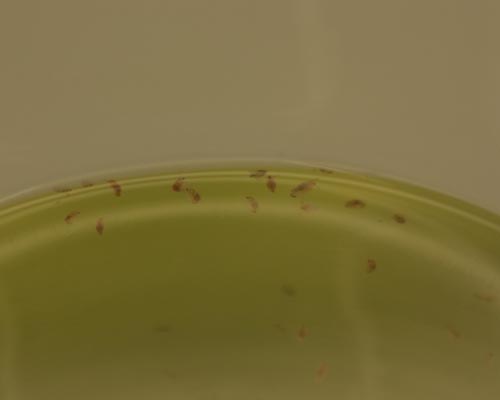OECD TG 211: Daphnia magna Reproduction test
Young female Daphnia (the parent animals, in house breeding at B.T.), aged less than 24 hours at the start of the test, will be exposed at determinate concentrations of test substance in the test medium (M4) for a period of 21 days in semi-static conditions.
At the end of the test, the reproductive output of the parent animals will be evaluated based on the total number of living offspring produced.
TEST SYSTEM
Daphnia magna
A toxic reference substance is tested twice a year to check the sensitivity of the organisms.

STUDY DESIGN
Range finding for acute immobilization test is carried out with at least 5 concentrations of the test substance and 1 untreated control (4 replicates/concentration or control) with 5 daphnids/replicate
Range finding for reproduction test includes at least 5 concentrations of the test substance and 1 untreated control (10 replicates/concentration or control) with 1 daphnid/replicate
Limit test is carried out with 1 concentration (as 10 mg/L or 100 mg/L) of the test substance and 1 untreated control (10 replicates/concentration or control) with 1 daphnid/replicate
Dose-response test includes at least 5 concentrations of the test substance and
1 untreated control (10 replicates/concentration or control) with 1 daphnid/replicate
Analytical checks, to verify the exposure concentrations in the medium, are performed at time 0, 3 times per week (in spent and fresh solutions) and at 21 days on control and on each test substance sample.
The analysis are performed using a method validated according to SANCO/825/00 rev. 8.1 and SANCO/3029/99 rev. 4 guidance documents.
ENDPOINTS
Reproduction: EC10, EC20, EC50 and LOEC/NOEC.
Study includes GLP management and reporting.
REFERENCES AND GUIDELINES
OECD Guideline fo Testing of Chemicals, No. 211 (2nd October 2012) – Daphnia magna reproduction test.
OECD Series on Pesticides, Number 67: “OECD guidance to the environmental safety evaluation of microbial biocontrol agents” (17th February 2012).
Environmental Canada, EPS 1/RM/44: “Guidance Document for Testing the Pathogenicity and Toxicity of New Microbial Substances to Aquatic and Terrestrial Organisms” (March 2004).
SANCO/825/00 rev. 8.1 (16/11/2010) – Guidance document on pesticide residue analytical methods.
SANCO/3029/99 rev. 4 (11/07/2000) – Residues: guidance for generating and reporting methods of analysis in support of pre-registration data requirements for Annex II (Part A, section 4) and Annex III (Part A, section 5) of Directive 91/414.
Study finder
Scientific Contact
Sabrina Mantilacci
E-mail: mantilacci@biotecnologiebt.it
Phone: +39 075 895 0045 – Ext. 268
Business Contact
Katy Lazzari
E-mail: klazzari@biotecnologiebt.it
Phone: +39 075 895 0045 – Ext. 246
Need more info? Send us a message
Fill in the form with the required information (*).
Our team will be happy to provide all the necessary support with regard to your request.


 English
English Italian
Italian